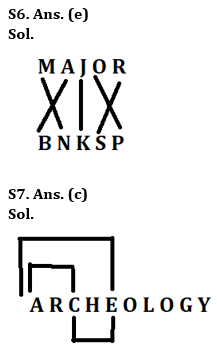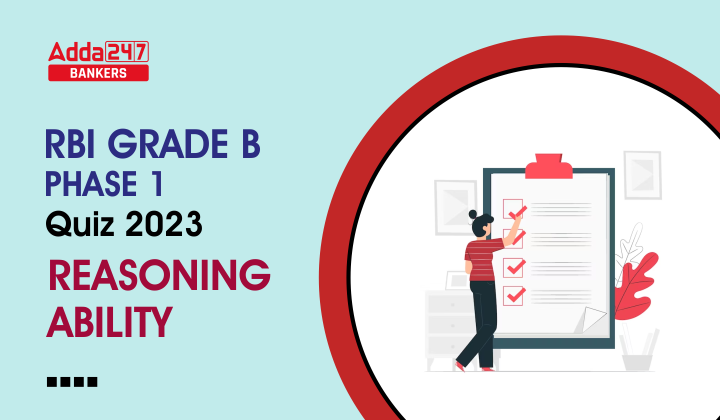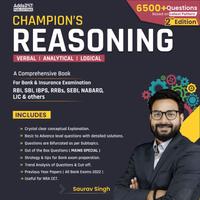Directions (1-5): In each of the questions below some statements are given followed by some conclusions. You have to take the given statements to be true even if they seem to be at variance with commonly known facts. Read all the conclusions and then decide which of the given conclusions logically follows from the given statements disregarding commonly known facts.
(a) If only conclusion I follows
(b) If only conclusion II follows
(c) If either conclusion I or II follows
(d) If neither conclusion I nor II follows
(e) If both conclusions I and II follow
Q1. Statements: P > Y ≤ H ≥ U > T = N
Conclusions: I. P > U
II. N < H
Q2. Statements: A ≥ S > D = C ≥ V > F > G ≥ H
Conclusions: I. V < D
II. H ≤ V
Q3. Statements: F > G ≥ T ≥ H > Y, T ≤ L = J < K
Conclusions: I. J > H
II. J = H
Q4. Statements: B > N ≥ M = K > L, W ≤ E = B, Q ≥ W > A
Conclusions: I. W > M
II. Q ≤ K
Q5. Statements: C > V = B > N ≥ M, K ≤ L = O ≤ P < V
Conclusions: I. O < C
II. B > L
Q6. In a certain code language, TABLE’ is coded as ‘BUCFM’ and ‘PRAYS’ is coded as ‘SQBTZ’, then how ‘MAJOR’ will be coded in the same manner?
(a) BNSQP
(b) BONSP
(c) BNOSP
(d) BNSPO
(e) BNKSP
Q7. How many such pairs of letters are in the word ‘ARCHEOLOGY’ each of which has as many letters between them (in both forward and backward directions) as they have between them in the English alphabetical series?
(a) One
(b) Two
(c) Three
(d) Four
(e) More than four
Q8. In the given words, if the 1st and 5th letters (from the left end) are interchanged and same is done with 3rd and 9th letters, 6th and 10th letters then which series would form an English meaningful word after the rearrangement?
I. RENIRTMETE
II. ADOTRNTIAA
III. LNOUINTISA
(a) Only I
(b) Only III
(c) Only I and II
(d) Only II and III
(e) Only I and III
Q9. If the vowels of the following words are arranged first as per the alphabetical order followed by the consonants as per the alphabetical order and the vowels are changed to the previous letter and consonants are changed to the next letter in the alphabetical series, then which will be the third letter from the right end of each newly formed word in the same order?
I. PERFORM
II. REVENUE
III. EMPLOY
(a) QON
(b) PON
(c) OGH
(d) POM
(e) None of these
Q10. If we arrange all the alphabets of the word DELIBRATELY in the alphabetical order from left end then the place of how many alphabets will remain unchanged after the rearrangement?
(a) One
(b) Two
(c) Three
(d) Four
(e) None of these
Solutions
Solutions (1-5):
S1. Ans. (b)
Sol. I. P > U (False)
II. N < H (True)
S2. Ans. (d)
Sol. I. V < D (False)
II. H ≤ V (False)
S3. Ans. (c)
Sol. I. J > H (False)
II. J = H (False)
S4. Ans. (d)
Sol. I. W > M (False)
II. Q ≤ K (False)
S5. Ans. (e)
Sol. I. O < C (True)
II. B > L (True)
S8. Ans. (e)
Sol. After interchanging the positions –
I. RENIRTMETE – RETIREMENT
II. ADOTRNTIAA – RDATAATION
III. LNOUINTISA – INSULATION

S9. Ans. (a)
Sol. After operation –
I. PERFORM – DNGNQSS
II. REVENUE – DDDTOSW
III. EMPLOY – DNMNQZ
So, QON is the correct answer.
S10. Ans. (a)
Sol. Given word – DELIBRATELY
After operation – ABDEEILLRTY
Hence, Y will remain unchanged.





 GA Capsule for SBI Clerk Mains 2025, Dow...
GA Capsule for SBI Clerk Mains 2025, Dow...
 The Hindu Review October 2022: Download ...
The Hindu Review October 2022: Download ...
 Without These Documents, Your Bank Exam ...
Without These Documents, Your Bank Exam ...





